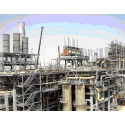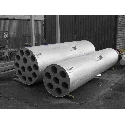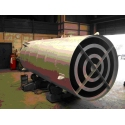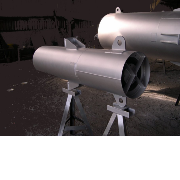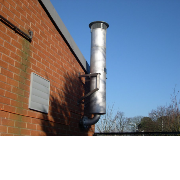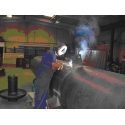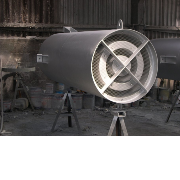Ventx Ltd
We are an industrial silencers manufacturer and design to meet a range of customer's requirements. There are a diverse number of applications where industrial silencers could be the perfect solution.
For us, as an industrial silencer manufacturer, we need to know about flowrate, up-stream pressure, up-stream temperature, connection size and type, and noise level required. With this information, we can begin to provide you with a positive, high performing solution.
-
Never Ignore Acoustic Insulation
10 May 2019The problem with certain facilities is the impact they have on the environment. Limiting this can be a bit of an issue without the right equipment. However, we can create reliable solutions for various needs. This includes our first rate industrial silencers. If you want to keep the noise down, they are your best option.
With silencers, every user wants to guarantee a smooth function. They also desire flawless noise attenuation. There’s only way to ensure this however; you must pay attention to specific areas. One of the most important is acoustic insulation. If you neglect this, there could be a reduction in performance or even a failure.
LOOK AT THE WHOLE SYSTEM
There’s something you must do when creating an acoustically and economically effective blow-off installation. You have to think about the whole system. However, something unfortunate happens rather frequently here. The high noise limitation obtainable with a contemporary vent silencer becomes null. The culprit is the noise released from valves or pipes close by. Said valves and pipes are either poorly insulated or not at all.
PREVENTION
The ideal approach to noise depletion is prevention via an appropriate system design. This is in particular for transfer pipes. The general rule here is that flow pipe diameters need to be huge and constant. Your pipes may have to be straight too. This allows for a low flow rate. It lowers the turbulent flow conditions and the pipe’s pressure loss as well.
For maximum efficiency, you must implement your measures comprehensively. It doesn’t make much sense for you to match a blow-off pipe’s dimension to a valve outlet and increase the diameter right before the silencer. This will cause a high blow-off speed inside the narrower duct section as a result. In turn it shall cause an increase in sound emissions coming from the pipe.
-
Which is The Best Silencer For Me?
10 May 2019Everyone wants a solution that fits in perfectly with their premises. This is especially true when they need industrial silencers. Using our first rate acoustic modelling software, we can create one for you. Once you’ve seen what our products can do, you won’t want to buy one from anyone else ever again.
When using heat exchangers and similar thermal products, noise can turn into a huge problem. Things remain this way regardless of the application or industry. However, there are ways to minimise the problem such as using silencers. They would lead to a more pleasant working environment.
The trouble with industrial silencers is that there are various models to choose from. To know which one is best for you, you’ll need to learn more about them. The following are examples of some of the products we offer.
BLOWER SILENCER
This style is common to in industrial processing and wastewater treatment. Since blowers typically make a lot of noise, the silencer becomes a necessity. When picking your own, think about what size and type is most appropriate. To lower noise efficiently, these two details are critical.
VACUUM PUMP SILENCERS
Vacuum pumps get rid of the liquid from gas flow vacuums. They manage this by employing rotary positive blowers and liquid ring pumps. Sadly though, they are loud and noisy. As a result they demand a high quality silencer.
VENT SILENCERSYou can this kind of silencer in chemical processing heat recovery systems, as well as gas and oil facilities. They silence noisy vents that release exhaust gases. To work properly, they normally need a pressure relief valve. This ensures that the gas does not build up to a dangerous pressure.
At Ventx, we have served the needs of numerous industries. This includes Service and Petro-Chem. With our cost effective and practical industrial silencers helping you, the noise will soon become an afterthought. If there is anything you’d like to discuss with us, please get in touch.
-
All About Our In-Line Silencers
10 May 2019Ventx Silencers are the go-to company for bespoke industrial silencers of all kinds. With over fifteen years experience in silencer design, and several decades in manufacturing and acoustic research, we have a thorough understanding of the issues surrounding industrial noise and their solutions.
We make units for a wide range of different applications across many industries. The silencer configuration in each case depends on the requirements of the system, and is also influenced by factors like legal noise limits. The three common types of silencer used in most processes are gas ejector silencers, vent silencers and direct in-line silencers.
Ventx silencers are so effective because of the diligence of our preparation. Expert silencer design doesn’t happen by accident, and our dedicated team always carefully lay the groundwork for each new project.
With the process data our computer model can predict where in the system noise is likely to be generated, and the loudness and frequencies involved. This data in turn can be used as a basis for an efficient and cost effective silencer design. Modelling your processes in this way means that we can even design effective silencers for industrial plants which are still on the drawing board if necessary. As long as you supply us with accurate drawings and materials data, we can make your silencers and have them ready to go by the time your facility is complete.
Ejector and vent silencers are used in cases where a charge of gas is released to another part of the system, or to atmosphere. An expansion chamber relieves the pressure of the charge, cutting the resultant noise level by reducing the energy in the discharge. At the same time, an absorptive core is used to attenuate specific frequencies by using a specific density of packing material which is custom tuned to the application.
In the case of an inline silencer, things can be a little more complicated as pressure reduction is much harder to achieve in a closed system. Installing an expansion chamber in the middle of the pipework could cause unpredictable pressure variations which could result in anything from loss of flow to extensive damage to valves and conduits as a result of pressure build-up. At the very least, such an arrangement would likely just refer problem noise to another part of the system, rather than eliminating it.
Instead, an in line silencer will use a tuned absorption section to target problem frequencies. The predicted flow rate within the conduit dictates the diameter of the silencer – if the unit is too narrow, the acoustic material will be eroded by the pressure over time. The length is determined by the degree of attenuation, that is, by how much the noise must be reduced.
-
Silencers Suiutable for Air-Handling Systems
10 May 2019One of the biggest challenges that industrial professionals face is keeping the noise levels to a minimum. This is vital to ensure they comply with health and safety requirements. The trouble is that you need the right equipment to do this. However, we happen to be a first rate supplier of the silencers. For example, our steam vent silencer can prove to be a valuable addition to your property.
Noise limiting silencers are essential for reducing noise in air-handling systems. Many factors can lead to the noise. This includes the flow of air through components like branches and elbows. Air flows in straight ducts can also generate some unsettling sounds.
To combat the noise, you can use a series of silencers. We’ll be going over some of the ones we supply below. We shall also look at some interesting details about them.
ENGINE EXHAUST SILENCERS
Firstly, we’ll cover engine exhaust silencers. The clue as to how you use them is in the name. However, there are separate options available. With compact spaces where vertical space is scarce, low profile and puck-style ones are practical. They provide a tight fit for several applications. There are also single and dual-inlet models for both.
FAN SILENCER
The next design on our list is the industrial fan silencer. You can find them on the discharge or inlet side. One exception is when you’re working with air conditioning units that have the discharge and inlet ducted into inhabited spots. In these instances, you install the silencers on both sides of your fan. The types of fan silencers that exist include vaneaxial and industrial tubular designs.
At Ventx, we take great care when matching each of our silencers to the applications. This is the only way they can work correctly without undermining your systems. With our products, you can manage the noise coming from fans, ducts, generators, and more. We also offer a reliable steam vent silencer if these vents are producing loud noises.
Get in touch with us today if you would like additional information. We offer bespoke designs and ensure clients get the best returns.
-
Soundproofing and Sound Absorbing Aren't The Same
10 May 2019The air vent silencers we provide are useful when someone needs to limit the noise coming from their facility. This is their main purpose after all. What makes our designs so special is that we create them in a way that suits your personal requirements. Each one is bespoke so it will offer the best results.
When someone has a noise issue, they often don’t know what to do. When they consider the options it is easy to get confused. With the acoustical coin, there are two sides. Some products block or stop sounds outright. Others absorb the noises instead. It can therefore be tough to decide what to opt for. To help you understand the differences between the two, we’re going to talk about them here.
ABSORBING
We’ll begin by covering the absorptive side. There are utensils out there that can absorb the sounds inside a room. Usually, they’re fluffy, light, and soft objects or those with very complex textures. Many of them feel soft if you choose to touch them. Their function is to soften up the room’s surfaces and lower the echo. Our silencers operate and feel a bit different. However, they still fall under the absorptive category.
SOUNDPROOFING
Next, we’ll discuss the products that block sound. These materials can prevent sounds from leaving or entering a space. They are usually found within the walls themselves. Typically, they are cumbersome, dense, and heavy. Certain models are able to decouple the wall. This is so that one of the sides can’t come in contact with the other, creating a barrier that can reduce sound transmission.
At Ventx, we analyse your systems in order to get the design of our silencers right. We work to get as much information as possible so we can ensure a great result. When we provide a silencer, you shall have an efficient way of keeping the noise levels down.
We have the skills to offer air vent silencers to suit any needs but can also cater for various other noisy systems and pieces of machinery. If you want to know more about our business, you’re welcome to contact us anytime.
-
Maintain Your Silencers and Pneumatic Machines
10 May 2019Many industrial facilities must restrict the amount of noise they produce. You need certain pieces of equipment to do this. Even then, you must ensure that they have the right qualities. Our company can aid you here by supplying tailor made natural gas silencers.
Sometimes, you must fit silencers to pneumatic mechanisms. The equipment might have been in use for long periods. As a result, you may need to clean the exhaust port threads. Polluted exhaust air can meld with dirt and dust. When this happens it usually fills up the threads with a bulky paste. If you don’t clean the threads, your silencers can suffer damage during installation.
IT’S BENEFICIAL TO CLEAN YOUR SILENCERS
The silencers themselves shall benefit from some exterior cleaning as well. You can attempt to clean pollutants deep within the silencing materials. However, only those models employing large pore membranes will see improvements.
You’re free to cleanse metal silencers using any solvent that’s commercially available. Some silencers use porous plastics like sintered polythene. It is unwise to clean them with solvents based on chlorinated hydrocarbons because they can cause extensive damage to the product.
THE CLEANING PROCESS
This cleaning approach demands that you soak your utensil in the solvent. Do this for five minutes. Next, you will have to do some scrubbing using a nylon or hard bristle brush. We don’t recommend using wire brushes here because they could harm your silencer. Once you’re done brushing, blow your silencer clear using clean compressed air.
At Ventx, we provide natural gas silencers as acoustic cores or as complete units. Something we’ve learned is that numerous companies find it mandatory to use silencers. This is so they can adhere to the UK’s environmental and health & safety standards. We are happy to supply equipment that will ensure they do just that.
Whatever your needs are, we shall supply you with a solution that offers great value. If there is anything you wish to speak to us about, please contact our business.
-
Silencer Configuration Blog
10 May 2019Ventx is a proud owner of over 40 years of acoustic knowledge combined with 30 years of quality manufacturing experience. This has provided us with the expertise in providing a high quality and effective silencing solution to the noise that can often pollute industrial environments that utilise pipework, plumbing and ventilation systems. You may not be aware of the existence of industrial silencer solutions, nor realise that you could benefit from utilising them in your workplace; today, we will outline the silencer configuration we offer, and demonstrate how it can be of benefit to you.
What is a silencer?
Pipe work that has substances, gas and steam flowing through it can produce uncomfortable and irritating noise. This can be a nuisance and distraction to your work day, which can ultimately limit your work performance and efficiency. By fitting one of our custom-built vent silencer designs, this noise can be curbed, reduced and significantly quietened, to make your professional experience a more pleasant one.
What service do we offer?
Noise is a particularly difficult sense to measure, as it can be hard to tell when something is quieter or louder than before. Our advanced computer software can pick up even the most subtle changes in noise, giving an accurate reading that will allow our team to fit you with the perfect silencer.
Our team begin by looking at the flow rate of the substance passing through your pipes; this allows us to measure the exact diameter required for fitting your ventilation system. This will also prevent erosion of the silencer over time, saving you time and costs in the long run. The length of the silencer you choose is dependent on how reduced you wish the noise to be.
We offer a number of different type of silencers, dependent on your specific needs. Gas ejector silencers are ideal for pipes with steam or hydrocarbon gas flowing through them, whereas direct line silencers absorb sound rather than compress it in order to curb noise pollution. We also offer control valve silencers, which vary the flow of the substance as it flows and leave your pipes and ventilators. Regardless of your infrastructure, at Ventx we can accustom to your needs.
Furthermore, we can work around the pre-existing structure of your pipe and ventilation systems. There is no need to worry about time consuming and costly plumbing works; our industrial silencer solutions can be inserted into the existing pipework, either as a whole unit or an acoustic core. The result is an absorbed and higher frequency, which is harder for human ears to hear and results in a less noticeable noise.
-
Choosing The Right Design For Exhaust Ports
10 May 2019When we’re working, we all want the environments to be as quiet as possible. With our wide array of silencing solutions, this can become a reality. Our business excels in designing as well as supplying many styles, including blow off silencers. They are able to perform their duties without undermining the system they connect to.
Sometimes, circumstances will require you to fit silencers into the exhaust ports of your machines. Before you can do this, you must choose the right design. Many products do look the same, but the performance is what separates them. You need to ensure you select a suitable model.
HOW DO YOU CHOOSE A SILENCER?
The first stage in picking an appropriate model is to turn to the equipment manufacturer’s guide. Then, you must figure out the airflow requirements for the machine’s regular operation. You should compare these details to the flow rate data you get from the guide. This way, you can decide what the most fitting unit for the situation is. This step is always essential. You must ensure that you don’t fit undersized silencers.
BACK PRESSURE
There might be a scenario where back pressure probably won’t be an issue for you. If so, then you can fit any silencer offering sufficient airflow. Just make sure you consider the maximum cost and noise reduction.
In contrast, you may need to fit the silencer to the pneumatic controls of a press brake or friction clutch power press, or have to fit it to a polluted airline. If so, you must give special consideration to certain silencers. These are the ones that guarantee maintenance free and long working lives.
At Ventx, we make sure that every silencer is capable of achieving the correct results. We accomplish this through the use of our acoustic modelling software. It enables us to examine your systems and determine what kind of product would work with them. In addition it means all products, whether it is blow off silencers or another style, will be fit for purpose.
If you would like our help, please get in touch. We work with clients from many industries and offer as much support as we can.


